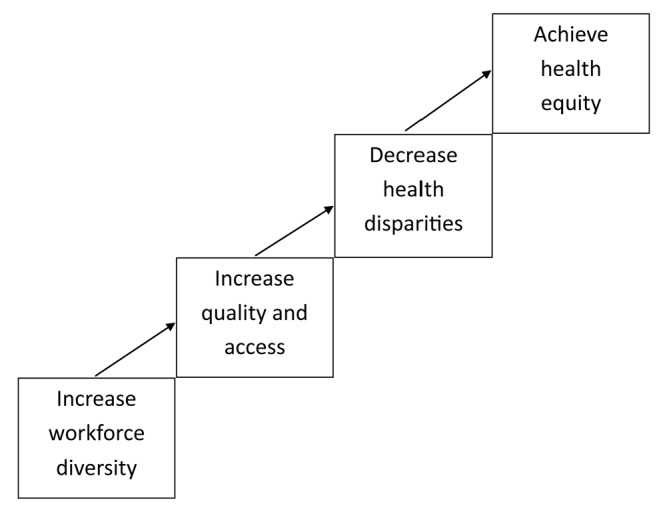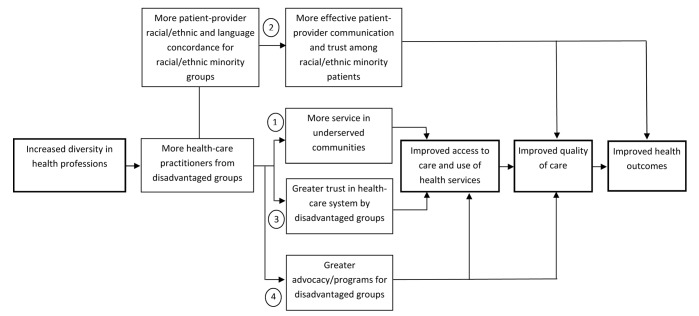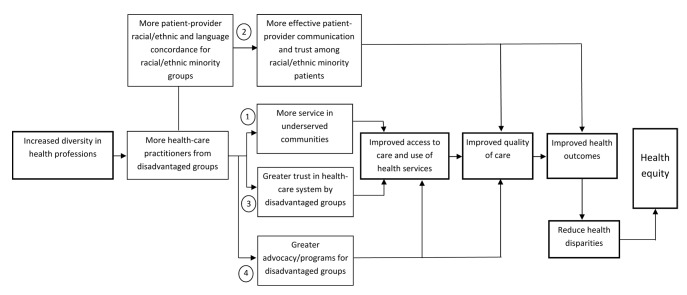Abstract
It is widely accepted that diversifying the nation's health-care workforce is a necessary strategy to increase access to quality health care for all populations, reduce health disparities, and achieve health equity. In this article, we present a conceptual model that utilizes the social determinants of health framework to link nursing workforce diversity and care quality and access to two critical population health indicators—health disparities and health equity. Our proposed model suggests that a diverse nursing workforce can provide increased access to quality health care and health resources for all populations, and is a necessary precursor to reduce health disparities and achieve health equity. With this conceptual model as a foundation, we aim to stimulate the conceptual and analytical work—both within and outside the nursing field—that is necessary to answer these important but largely unanswered questions.
Today, in the United States and throughout the world, an individual's ability to reach his or her full health potential is severely constrained by the individual's social group and economic status.1 Indeed, the evidence is overwhelming—the advantaged in society experience better and longer health when compared with the disadvantaged—and this stepwise health advantage is patterned along a social and class gradient that results in systemic and pervasive health disparities. One proposed approach to maximizing the health potential of every member of society and reducing health disparities is to increase access to quality health care and health-care resources.1–3
Achieving health equity is a goal that cascades down through each of the Health Resources and Services Administration's (HRSA's) six bureaus and nine offices. HRSA's Bureau of Health Professions (BHPr) demonstrates its shared commitment to health equity by ensuring fair and equitable access to the resources necessary to achieve optimal health, regardless of a population's social or economic status.4 BHPr has contributed an evidence-based conceptual framework to the limited but encouraging literature that supports a positive correlation between a racially/ethnically diverse health workforce and improved patient outcomes. Two evidence-based assumptions in the BHPr framework linking health professions diversity to health outcomes are: (1) health professionals who are from racial/ethnic minority groups and come from socioeconomically disadvantaged backgrounds are more likely to serve in resource-poor and rural communities, where racial/ethnic minority groups and the poor are overrepresented; and (2) racial/ethnic and language concordance will improve patient-provider communication, tolerance, trust, and decision-making, thereby increasing access to, and quality of, the interaction that would result in improved health outcomes (Figure 1).5
Figure 1.
Conceptual framework linking health professions diversity to health outcomes, 2006a
aDepartment of Health and Human Services (US), Health Resources and Services Administration, Bureau of Health Professions. The rationale for diversity in the health professions: a review of the evidence. Rockville (MD): HHS; 2006.
The Division of Nursing (DN), located within BHPr, aims to extend the conceptual framework linking health-care workforce diversity to increased access and quality to include its potential impact on population health by describing a potential pathway connecting a diverse nursing workforce to decreased health disparities and improved health equity (Figure 2). The DN supports programs that ensure the adequate supply and distribution of nursing professionals prepared to deliver high-quality, competent care. The nursing workforce ideally should reflect the cultural and social needs and values of the communities in which they serve. Furthermore, we believe that equitable access to quality health care and health resources is critical to reducing health disparities and achieving health equity. Given this orientation, we suggest that nursing workforce diversity is not an end unto itself; rather, we envision nursing workforce diversity as a key strategy for increasing access to quality health care and health-care resources.
Figure 2.
Expanded conceptual model linking health professions diversity to health disparity and health equity outcomes, 2012a
aAdapted from: Department of Health and Human Services (US), Health Resources and Services Administration, Bureau of Health Professions. The rationale for diversity in the health professions: a review of the evidence. Rockville (MD): HHS; 2006.
THE NURSING WORKFORCE DIVERSITY PROGRAM
The primary lever in which the DN implements its diversity agenda is through its Nursing Workforce Diversity (NWD) program. The NWD program was legislatively mandated under Title VIII of the 1989 Public Health Service Act, with authority to increase nursing education opportunities for individuals from disadvantaged backgrounds (including racial/ethnic minority groups) who historically have been underrepresented among registered nurses.6 The NWD legislation authorized individual-level financial instruments (e.g., scholarships and stipends), mentoring, and social support strategies as targeted approaches to address the gaps in nursing workforce achievement between historically advantaged and disadvantaged populations. As of 2013, the NWD program had awarded approximately $160 million in institutional grants to U.S. schools of nursing to facilitate disadvantaged individuals' navigation through the nursing pipeline. The Patient Protection and Affordable Care Act of 2010 expanded the NWD program's authority to increase the workforce of registered nurses with advanced degrees by assisting registered nurses with diplomas or associate degrees to become baccalaureate-prepared registered nurses, and by preparing practicing registered nurses for advanced nursing education.7
In 2011, the DN began a comprehensive two-year evaluation of the NWD program grant portfolio to reassess the relative impact of the program's individual-level strategies and incentives—scholarships and loans, mentoring and social support in nursing school enrollment, retention, and graduation. One objective of the program evaluation is to identify grantee projects that could serve as best-practice models for diversifying the workforce. The completed program evaluation is expected to yield a catalogue of successful workforce diversity strategies that could be modeled and scaled throughout the country. We hope to also gain a greater understanding of the seemingly intransigent multilevel factors that impede our ability to advance a robust workforce diversity agenda. In fact, the evaluation data should provide critical insights regarding the program's effectiveness and will inform our future investments in the nursing workforce diversity portfolio.
This initial program evaluation work redirected and expanded the DN's thinking to consider innovative strategies to address the larger social and structural forces that provide context for the underrepresentation of disadvantaged social groups in the registered nurse workforce. The division is convinced that additional social- and structural-level strategies, such as institutional leadership buy-in and multi-sector partnerships, should complement and support—not supplant—existing legislation that directs individual-level strategies such as scholarships, loans, mentoring, and social support activities.
CONCEPTUAL MODEL
As part of the initial NWD program evaluation, DN staff reviewed the literature within the overarching domains of workforce diversity, health-care access and quality, health disparities, health equity, and the social determinants of health (SDH). The purpose of the literature review was to gain an overall sense of which programs and strategies were achieving the greatest gains in workforce diversity and why those programs and strategies were successful. Based on the review of the literature, we inductively developed a conceptual model with four basic constructs comprising a sequential set of linear relational statements. The three-dimensional (3D) conceptual model—diversity, disparities, and determinants (Figure 3)—depicts a stepwise relationship among nursing workforce diversity, health-care access and quality, health disparities, and health equity, all within the context of an SDH framework.
Figure 3.
Nursing in 3D conceptual model depicting the stepwise relationship among nursing workforce diversity, health-care access and quality, health disparities, and health equity

3D = diversity, disparities, and social determinants
The first construct of the model is nursing workforce diversity. Diversity includes those historically underrepresented groups in nursing—racial/ethnic minority groups, men, people with disabilities, and the educationally and economically disadvantaged—as key social groups requiring targeted efforts and dedicated resources to close the achievement gap and increase their proportional representation in nursing. The second 3D construct is access to quality health care. Admittedly, health-care access and health-care quality are two separate conceptual domains; in the 3D conceptual model, the two concepts have been linked. The model hypothesizes that access to quality care implies safe, timely, efficient, effective, equitable, respectful, and culturally aligned care that meets a health need.2,8 The third construct is health disparities. Health disparities are those entrenched variations in health and health-care outcomes that are closely linked with economic, social, and environmental disadvantage.1–3 The fourth construct is health equity. Health equity is conceptualized as that highest standard of health attainable for all populations, regardless of social group status or historical disadvantage.1 In the conceptual framework linking health professions diversity to health outcomes,5 health outcomes are presented as an individual-level construct. In the 3D model, health outcomes are framed at the population level as health disparities and health equity. The 3D model is proposed as one potential pathway to achieving health equity from the starting point of a diverse nursing workforce strategy.
In August 2012, the DN sponsored an invitational interdisciplinary summit entitled Nursing in 3D: Workforce Diversity, Health Disparities, and Social Determinants of Health. The summit's mission and goals emerged from the constructs articulated in the 3D conceptual model. The overarching goal of the summit was to provide our nursing stakeholders and grantee communities with the intellectual and conceptual tools necessary to apply the SDH framework to advance the agenda for nursing workforce diversity and health equity. Experts in the fields of nursing workforce diversity, health-care quality and access, health disparities, and SDH were convened by HRSA to detail the full range of academic and health system factors, as well as the social, economic, and environmental determinants that influence health workforce diversity and health equity.
At the conclusion of the summit, there was sufficient momentum to forge ahead with using the 3D conceptual model to frame the DN's nursing workforce diversity agenda. Moreover, we believed that approaching nursing workforce diversity through the lens of SDH would spawn innovations and facilitate the development of effective approaches to reduce, and eventually eliminate, health disparities to achieve population health equity.
With the publication of this special supplement dedicated to the 3Ds, the DN hopes to advance the scholarly inquiry around the intersecting goals of increased workforce diversity, fair and equal access to quality health care and health-care resources, elimination of health disparities, and achievement of health equity. To that end, we aim to expand our DN grant portfolio to include an organized and coherent set of novel and innovative projects that test the assumptions and constructs in the 3D conceptual model with a deliberate attempt to further refine and expand the model and its utility in nursing. Middle-range theories both within and outside of nursing that are compatible with the 3D model will need to be utilized to test the model's basic theoretical statements and assumptions, establish priorities for future work, and further refine the research methods and measures in the intersecting fields of workforce diversity, health-care quality and access, health disparities and health equity, and SDH.9
For example, the exploratory and confirmatory work that is underway to test the linkage assumption that increasing workforce diversity does indeed have a quantifiable impact on health-care quality and access needs to be expanded. Similarly, while there is fairly consistent evidence to support the theory that increasing access to quality health care for the most vulnerable among us leads to a reduction in health disparities,3,10 there is also a competing literature that presents compelling evidence that health disparities are an entrenched feature of our social fabric and, despite increased access to health care, health disparities among advantaged and disadvantaged populations remain.1,2,11–13 While work has already begun in the field to understand the relative impact of decreasing health disparities on achieving health equity, this work is still underdeveloped. Until now, the consensus in the field has been that the relationship between health disparities and health equity is inverse and proportional, and, as the rates of health disparities decreased, a commensurate and proportional increase in the rates of health equity would occur. In other words, when health disparities are eliminated, health equity would be achieved.1,14
Meanwhile, to demonstrate the DN's focus and commitment to SDH and health equity, a funding opportunity was released in January 2013 that requires NWD applicants to propose innovative workforce diversity projects that offer multilevel, evidence-based approaches that incorporate SDH into strategies to diversify the nursing workforce with a goal of improving population health equity. The release of the 2013 funding opportunity makes the urgency to simultaneously develop the relevant measures and metrics to chart progress toward our goal of health equity all the more relevant.
CONCLUSION
In summary, the DN aims to create synergistic work and active engagement among our professional peers and multiple stakeholder communities who share a commitment to increase workforce diversity, ensure access to quality health care and health-care resources, and reduce—and eventually eliminate—health disparities as a means of achieving population health equity.
Footnotes
The views expressed in this article are those of the authors and do not necessarily represent those of the Health Resources and Services Administration or the U.S. Department of Health and Human Services.
REFERENCES
- 1.World Health Organization, Commission on Social Determinants of Health. Geneva: WHO; 2008. Closing the gap in a generation: health equity through action on the social determinants of health. CSDH final report. [Google Scholar]
- 2.Department of Health and Human Services (US), Agency for Healthcare Research and Quality. National healthcare disparities report, 2011. Rockville (MD): AHRQ; 2012. [[cited 2013 Sep 4]]. Also available from: URL: http://www.ahrq.gov/research/findings/nhqrdr/nhdr11/nhdr11.pdf. [Google Scholar]
- 3.Department of Health and Human Services (US), Office of Disease Prevention and Health Promotion. Healthy people 2020. ODPHP publication no. B0132. November 2010 [cited 2013 Sep 4] Available from: URL: http://www.healthypeople.gov/2020/TopicsObjectives 2020/pdfs/HP2020_brochure_with_LHI_508.pdf.
- 4.Department of Health and Human Services (US), Health Resources and Services Administration. Strategic plan: vision, mission, goals, sub-goals, and guiding principles [cited 2013 Jan 10] Available from: URL: http://www.hrsa.gov/about/strategicplan.html.
- 5.Department of Health and Human Services (US), Health Resources and Services Administration, Bureau of Health Professions. The rationale for diversity in the health professions: a review of the evidence. Rockville (MD): HHS; 2006. [[cited 2013 Sep 3]]. Also available from: URL: http://bhpr.hrsa.gov/healthworkforce/reports/diversity reviewevidence.pdf. [Google Scholar]
- 6.Title VIII, § 821 of the Public Health Service Act (42 U.S.C. 296 m) as amended by § 5404 of the Patient Protection and Affordable Care Act (Pub. L. No. 111-148) [Google Scholar]
- 7. Pub. L. No. 111-148, 124 Stat. 119 (March 23, 2010) [Google Scholar]
- 8.Institute of Medicine, Committee on Quality of Health Care in America. Crossing the quality chasm: a new health system for the 21st century. Washington: National Academies Press; 2001. [Google Scholar]
- 9.Burns N, Groves SK. Frameworks. In: Burns N, Groves SK, editors. The practice of nursing research: conduct, critique, and utilization. 5th ed. St. Louis: Elsevier/Saunders; 2005. pp. 121–55. [Google Scholar]
- 10.Jemal A, Simard EP, Dorell C, Noone AM, Markowitz LE, Kohler B, et al. Annual report to the nation on the status of cancer, 1975–2009, featuring the burden and trends in human papillomavirus (HPV)-associated cancers and HPV vaccination coverage levels. J Natl Cancer Inst. 2013;105:175–201. doi: 10.1093/jnci/djs491. [DOI] [PMC free article] [PubMed] [Google Scholar]
- 11.McPheeters ML, Kripalani S, Peterson NB, Idowu RT, Jerome RN, Potter SA, et al. Rockville (MD): Department of Health and Human Services (US), Agency for Healthcare Research and Quality; 2012. Quality improvement interventions to address health disparities. Closing the quality gap: revisiting the state of the science. Evidence report no. 208. AHRQ publication no. 12-E009-EF. [PMC free article] [PubMed] [Google Scholar]
- 12.Williams DR, Sternthal M. Understanding racial-ethnic disparities in health: sociological contributions. J Soc Health Behav. 2010;(51 Suppl):S15–27. doi: 10.1177/0022146510383838. [DOI] [PMC free article] [PubMed] [Google Scholar]
- 13.Satcher D, Fryer GE, Jr, McCann J, Troutman A, Woolf SH, Rust G. What if we were equal? A comparison of the black-white mortality gap in 1960 and 2000. Health Affairs (Millwood) 2005;24:459–64. doi: 10.1377/hlthaff.24.2.459. [DOI] [PubMed] [Google Scholar]
- 14.Grantmakers in Health. Striving for health equity: opportunities as identified by leaders in the field. 2012. Jul, [[cited 2013 Sep 4]]. Available from: URL: http://www.gih.org/files/FileDownloads/Striving_for_Health_Equity_July_2012.pdf.




